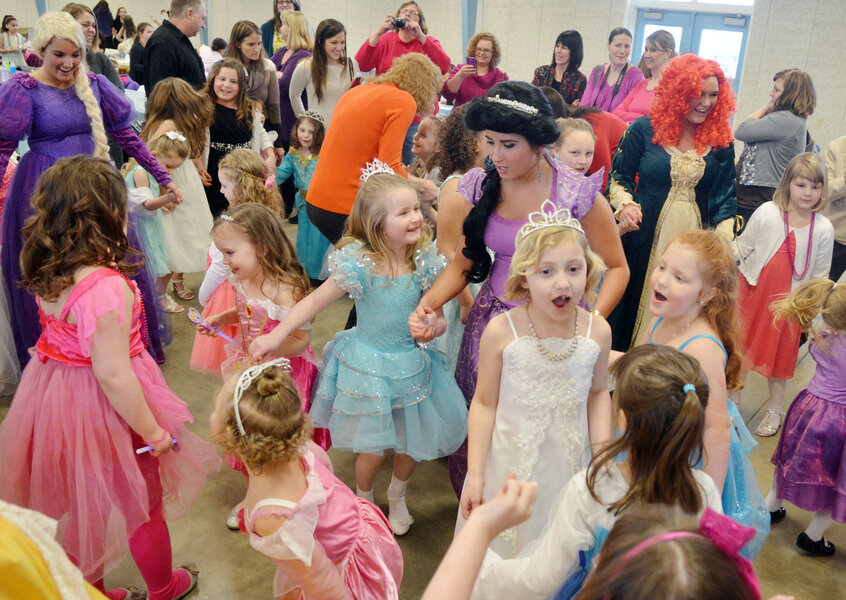Pink princess debate: Marketers, not moms, are the problem
Loading...
Last week, New York magazine and Slate published pieces asking why so many moms have a problem with pink and with princesses.
“What’s the problem with pink, anyway?” gripes Yael Kohen in New York. Then, building upon Ms. Kohen’s piece, Slate senior editor Allison Benedikt demands: ”What is it with you moms of girls? I have never met a single one of you who isn’t tortured about pink and princesses.” Her annoyance is palpable.
Both writers proceed to defend all things pink and princess. ”We treat pink — and the girls who like it — with...condescension,” Kohen states, while Ms. Benedikt adds, ”Moms of daughters need to chill out.”
Let’s take a step back, please. I am the author of a forthcoming book called "The Princess Problem: Guiding Our Girls Through the Princess-Obsessed Years," and Kohen and Benedikt’s arguments are wrong on several levels. By pontificating on the subject without actually talking to the moms they’re criticizing, they’ve missed the point.
Having interviewed more than 50 parents about princess culture, and dozens of experts as well, I’d like to state this categorically: No one is blaming girls. To suggest otherwise is to make a straw man argument that distracts from the real issues at hand.
Furthermore: No one thinks that pink is inherently a problem. Pink is not the “color of oppression,” as Benedick charges sarcastically.
No, no — the problem is not with the girls or the color pink. It’s with the marketing, because that marketing is reducing girls’ choices.
As the mother of a young boy, Benedikt can’t understand why the mom of a little girl she knows spent her own daughter’s princess-themed birthday party apologizing for all the pink and saying things like, “The pink thing, I know — it’s crazy!”
Since Benedikt is a journalist, she would have been smart to ask the mom what, exactly, was “crazy” about “the pink thing.” But instead, Benedikt appears to have arrived at her own conclusion: The mom is the crazy one, because, as Benedikt notes incredulously, she was criticizing the very extravaganza that she herself had organized!
Now, if either writer had bothered to talk with moms of girls, like I did for my book – or, for that matter, to connect with the authors and activists who’ve been critiquing pink girly-girl culture for several years, like me, Peggy Orenstein, Michele Yulo, Melissa Wardy, or the team behind Pinkstinks – they would have learned something important. In the marketplace, products that are pink and princessy now dominate the girls’ sections. The marketing is so insidious that the moms I interviewed complained that it is virtually inescapable – and to very young children, it implies that pink and princesses are the ONLY good choices for girls.
In other words, it wasn’t that they didn’t want their daughters to like pink or princesses. Far from it. It was just that they didn’t want their daughters to only like pink or princesses.
That, I’d wager, is what the mom who threw the princess-themed birthday party was fretting about. You know how the subtitle of my book includes the phrase “princess-obsessed years”? I’m not exaggerating when I say that there are many little girls out there who only want pink, only want princesses, and that the obsessiveness spills over into every aspect of their families’ lives.
In Kohen’s piece, she defends pink princess products and marketing because, she says, “plenty of girls seem to love it.” This is true – plenty of girls do love it. I would never tell a girl that she’s wrong to enjoy what she enjoys. Princess culture is full of pleasures for our little ones. It’s fun and sparkly and such a source of delight!
Kohen is missing a critical piece of the puzzle, however. Pink princess marketing is so forceful, backed by so many billions of dollars, that it’s not really a choice anymore. It’s proscriptive and it’s coercive.
According to a study published by a research team from California State University and New York University, approximately two-thirds of preschool girls go through a phase in which they believe that their sex (the fact that they are girls) fully depends on external factors, like how they dress, because they don’t understand that sex is determined biologically. Fearful of losing their gender identities, and declaring their joy in being girls, they latch onto the most obvious stereotypical markers of their gender.
The same study asserts that developmental phase used to manifest in girls as a refusal to wear anything but dresses. (In contrast, in boys, it manifests as an avoidance of all things girlish.) Now, it manifests in girls as a refusal to associate with anything but pink and princess – a full-blown obsession.
Perhaps that casts a more sympathetic light on the mom Benedikt slammed for planning a pink princess party despite feeling conflicted about it. The mom probably thought the “pink thing” was “crazy” because of its intensity, its apparent grip on her daughter, and its inescapability in the marketplace. And for a mom who wants her daughter to have a delightful birthday experience, but is worried about the consequences of all this pink princess stuff overrunning her daughter’s life, it’s a no-win situation.
Think about it. That is crazy.
Also a problem: The minority of girls who actively reject things that are stereotypically girly because they are gender-nonconforming (approximately 1 in 10 children, according to a recent Harvard University study) are left out, treated by peers and even adults as somehow defective. The Harvard study suggests that such children leave childhood with post traumatic stress disorder.
Meanwhile, parents whose daughters are inextricably caught up in pink princess culture have concerns about its effects. For one thing, princess culture focuses so strongly on physical appearance that it teaches girls that how they look is incredibly important. It teaches little girls to seek praise for their appearance – which is why so many little girls insist on wearing their princess play-clothes out of the house. People gush over them. This upsets parents who know that it’s what’s inside that counts, and who want their daughters’ sense of self-worth to come from within.
Also, as far as story lines go, the princess script is limiting. Parents I interviewed told me stories about their daughters lying around helplessly waiting for their princes to come rescue them – marking dramatic changes in their previously active and energetic play patterns.
Furthermore, even though Kohen notes that princess products "reflect subtle, but profound changes in the way our society views its girls and their girlyness,” with princesses who are “more dynamic,” she’s missing something: girls may adore their "Brave" and "Frozen" DVDs, but in many homes – indeed, across the Disney Princess franchise – "Cinderella" and "Sleeping Beauty" still reign supreme.
And although princesses on screen have indeed become more dynamic in our post-girl-power world, many of the toys – especially the dolls that preschool girls cherish – all seem to regress to the mean. Strong princess characters such as Merida from "Brave" get reduced down to sparkly fashion objects in ways that completely undercut the empowering messages from their films.
Here’s what’s happening: In the marketplace, products that are pink and purple are “for girls,” while everything else is “for boys.” As a mom, I see this playing out time and again. Anything with a hint of pink on it, my 5-year-old son rejects. “That’s too girly,” he’ll argue, even if there’s only the tiniest hint of pink on a product. Where did he pick up on this? Not from me! He’s absorbed this lesson from the culture we’re immersed in – from the marketing that relies on stereotypes to segregate our children, maximizing profits at the expense of children’s healthy gender identity development and well-being.
The moms of girls who are fretting about pink princess culture don’t need to be slammed by Benedikt, Kohen, and others. Jumping to conclusions doesn’t help anybody, and "pink and princess" really doesn’t need to be the latest installment of the Mommy Wars. If we can understand and address the root of the problem together, we can foster a healthier world for all of our children – boys and girls alike.
The Christian Science Monitor has assembled a diverse group of the best family and parenting bloggers out there. Our contributing and guest bloggers are not employed or directed by the Monitor, and the views expressed are the bloggers' own, as is responsibility for the content of their blogs. Rebecca Hains blogs at rebeccahains.wordpress.com.






